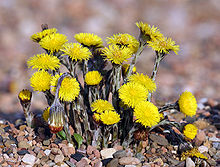- Tussilago farfara
-
Coltsfoot 
Scientific classification Kingdom: Plantae (unranked): Angiosperms (unranked): Eudicots (unranked): Asterids Order: Asterales Family: Asteraceae Genus: Tussilago Species: T. farfara Binomial name Tussilago farfara
L.Tussilago farfara, commonly known as Coltsfoot, is a plant in the family Asteraceae.
It has been used medicinally as a cough suppressant. The name "tussilago" itself means "cough suppressant." The plant has been used historically to treat lung ailments such as asthma as well as various coughs by way of smoking. Crushed flowers supposedly cured skin conditions, and the plant has been consumed as a food product.
The discovery of toxic pyrrolizidine alkaloids in the plant has resulted in liver health concerns.
Contents
Description
Coltsfoot is a perennial herbaceous plant that spreads by seeds and rhizomes. Tussilago is often found in colonies of dozens of plants. The flowers, which superficially resemble dandelions, appear in early spring before dandelions appear. The leaves, which resemble a colt's foot in cross section, do not appear usually until after the seeds are set. Thus, the flowers appear on stems with no apparent leaves, and the later appearing leaves then wither and die during the season without seeming to set flowers. The plant is typically between 10 - 30 cm in height.
Distribution
Coltsfoot is native to several locations in Europe and Asia. It is also a common plant in North America and South America where it has been introduced, most likely by settlers as a medicinal item. The plant is often found in waste and disturbed places and along roadsides and paths. In some areas it is considered an invasive species.
Synonym
Other common names include Tash Plant, Ass's foot, Bull's foot, Butterbur, Coughwort, Farfara, Foal's foot, Foalswort, Horse Foot and Winter heliotrope. Sometimes it is confused with Petasites frigidus, or Western Coltsfoot.
Uses
Coltsfoot is used as a food plant by the larvae of some Lepidoptera species including The Gothic and Small Angle Shades. The Coltsfoot is also worked by the honey bee (Apis mellifera mellifera).
Coltsfoot has also become a popular confectionery product made by using Coltsfoot essence to create a hardened rock that is used to soothe sore throats and chesty coughs; the recipe has been developed exclusively by Stockley's Sweets of Oswaldtwistle, UK and has become a favourite medicinal sweet around the globe known simply as Coltsfoot rock.
Toxicity
Tussilago farfara contains tumorigenic pyrrolizidine alkaloids.[1] Senecionine and senkirkine, present in coltsfoot, have the highest mutagenetic activity of any pyrrolozidine alkaloid, tested using Drosophila melanogaster to produce a comparative genotoxicity test.[2][3] There are documented cases of coltsfoot tea causing severe liver problems in an infant, and in another case, an infant developed liver disease and died because the mother drank tea containing coltsfoot during her pregnancy.[4][5] In response the German government banned the sale of coltsfoot. Clonal plants of colstfoot free of pyrrolizidine alkaloids were then developed in Austria and Germany.[6] This has resulted in the development of the registered variety Tussilago farfara Wein which has no detectable levels of these alkaloids.[7]
Gallery
References
- ^ Fu, P.P., Yang, Y.C., Xia, Q., Chou, M.C., Cui, Y.Y., Lin G., "Pyrrolizidine alkaloids-tumorigenic components in Chinese herbal medicines and dietary supplements", Journal of Food and Drug Analysis, Vol. 10, No. 4, 2002, pp. 198-211[1]
- ^ Röder, E., "Medicinal plants in Europe containing pyrrolizidine alkaloids", Pharmazie, 1995, pp83-98. Reprinted on Henriette's Herbal website.[2]
- ^ Frei, H.J., Luethy, J., Brauchli, L., Zweifel, U., Wuergler, F.E., & Schlatter, C., Chem. Biol. Interact., 83: 1, 1992
- ^ Sperl, W., Stuppner, H., Gassner, I.; "Reversible hepatic veno-occlusive disease in an infant after consumption of pyrrolizidine-containing herbal tea." Eur J Pediatr. 1995;154:112–6.
- ^ Roulet, M., Laurini, R., Rivier, L., Calame, A.; "Hepatic veno-occlusive disease in newborn infant of a woman drinking herbal tea." J Pediatrics. 1988;112:433–6.
- ^ Wawrosch, Ch.; Kopp, B.; Wiederfield, H.; "Permanent monitoring of pyrrolizidine alkaloid content in micropropagated Tussilago farfara L. : A tool to fulfill statutory demands for the quality of coltsfoot in Austria and Germany", Acta horticulturae, 2000, no. 530, pp469-472[3]
- ^ Wawrosh C.,"In Vitro Cultivation of Medicinal Plants" cited in Yaniv Z. and Bachrach U., Eds "Handbook of Medicinal Plants", The Hawthorne Medical Press NY Lond. 2005
- R. Schubert & G. Wagner: Botanisches Wörterbuch Ulmer, Stuttgart 1993, ISBN 3-8252-1476-1 (German)
- H. Haeupler & Th. Muer: Bildatlas der Farn- und Blütenpflanzen Deutschlands Ulmer Verlag, Stuttgart, 2000. ISBN 3-8001-3364-4. (German)
- Gerhard Madaus: Lehrbuch der biologischen Heilmittel Bd 1. Heilpflanzen. G. Thieme, Leipzig 1938, Olms, Hildesheim 1979. ISBN 3-487-05890-1 (German)
- Guide des plantes sauvages comestibles et toxiques, les guides du naturaliste, François Couplan et Eva Stinner ISBN 2 603 00952 4 (French)
- Кирпичников М. Э. Семейство сложноцветные, или астровые (Asteraceae, или Compositae) // Жизнь растений. В 6-ти т. / Под ред. А. Л. Тахтаджяна. — М.: Просвещение, 1981. — Т. 5. Ч. 2. Цветковые растения. — С. 462—476. — 300000 экз. (Russian)
External links
Categories:- Senecioneae
- Medicinal plants
- Honey plants
- Alpine flora
- Invasive plant species
- Plants described in 1753
- Plants used in Traditional Chinese medicine
- Flora of Algeria
- Flora of Morocco
- Flora of Iran
- Flora of Turkey
- Flora of Georgia (country)
- Flora of Russia
- Flora of India
- Flora of Nepal
- Flora of Denmark
- Flora of Ireland
- Flora of Norway
- Flora of the United Kingdom
- Flora of Germany
- Flora of Estonia
- Flora of Latvia
- Flora of Lithuania
- Flora of Greece
- Flora of Italy
- Flora of Romania
- Flora of France
- Flora of Spain
- Demulcents
Wikimedia Foundation. 2010.




